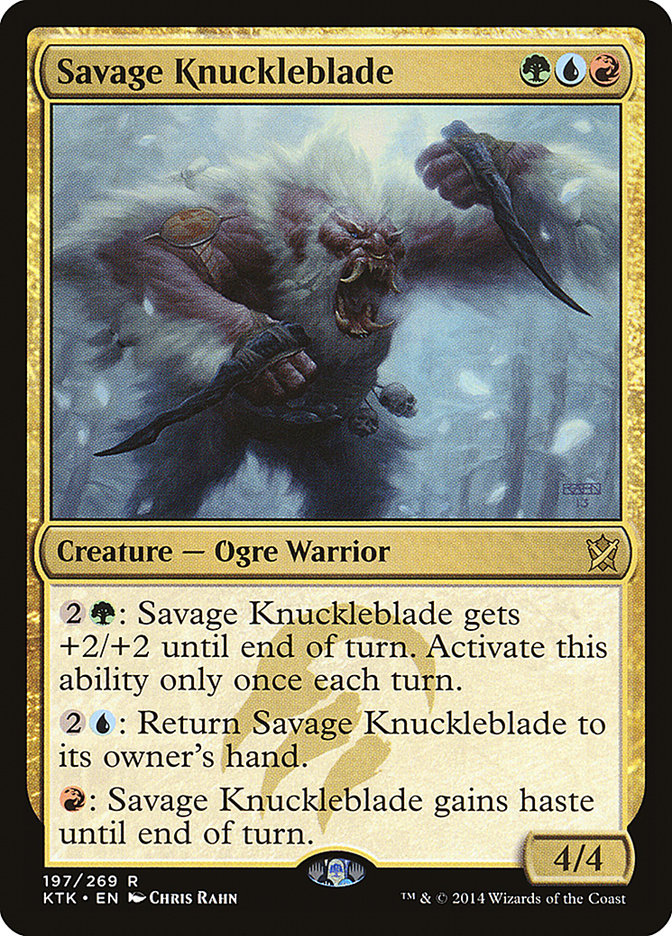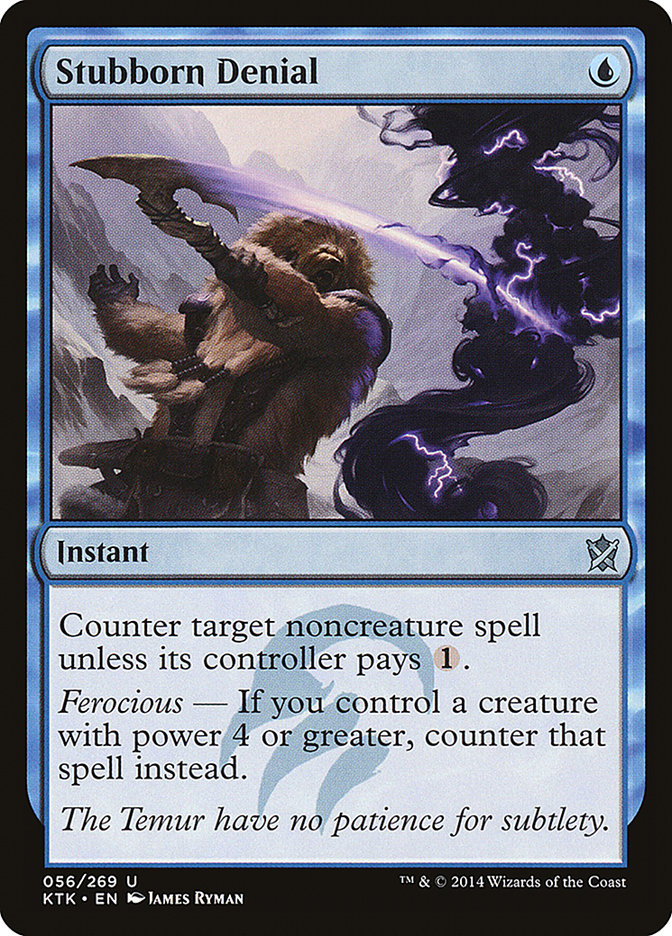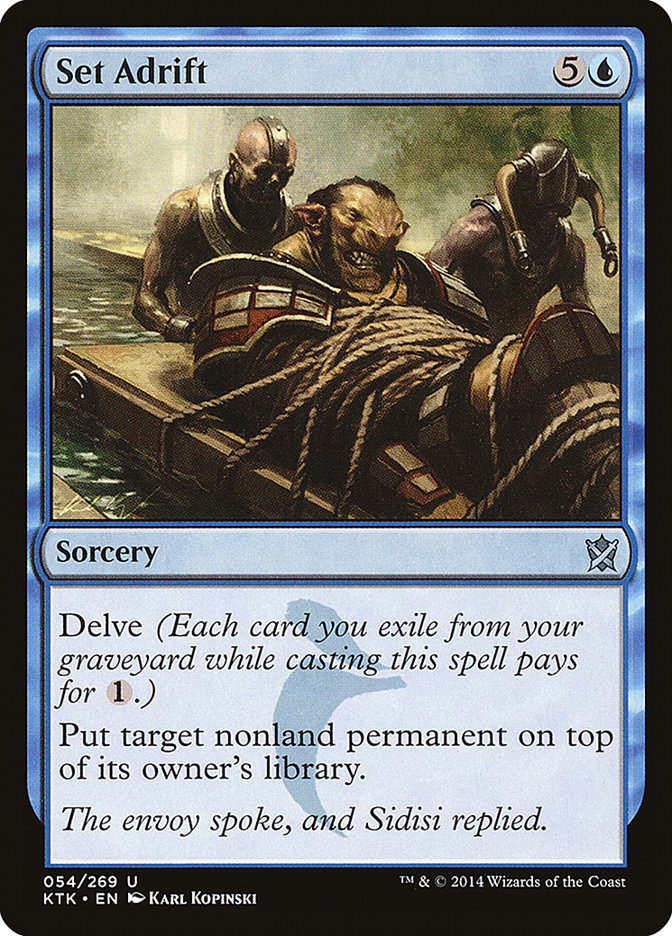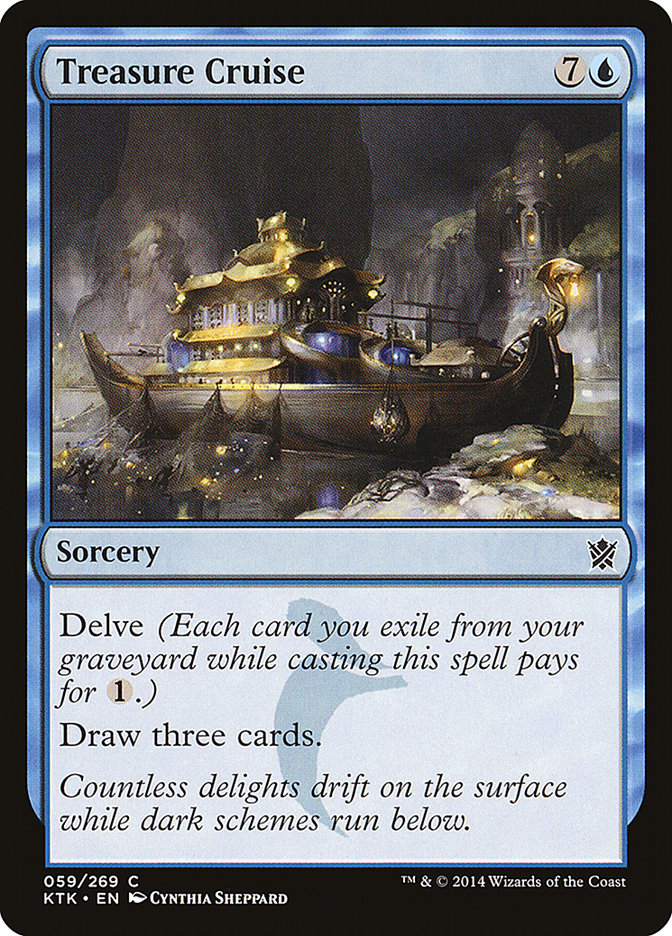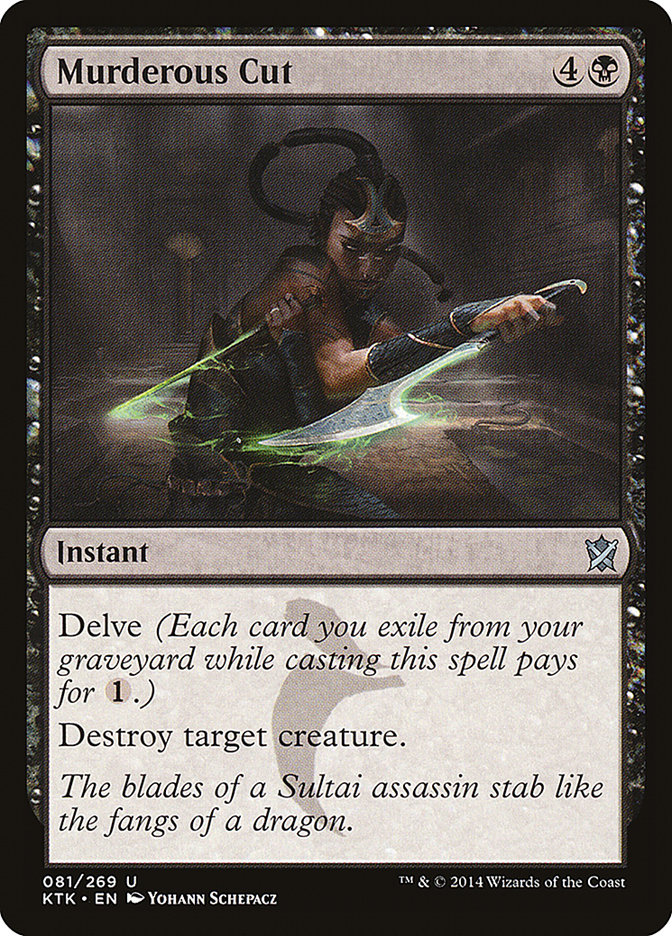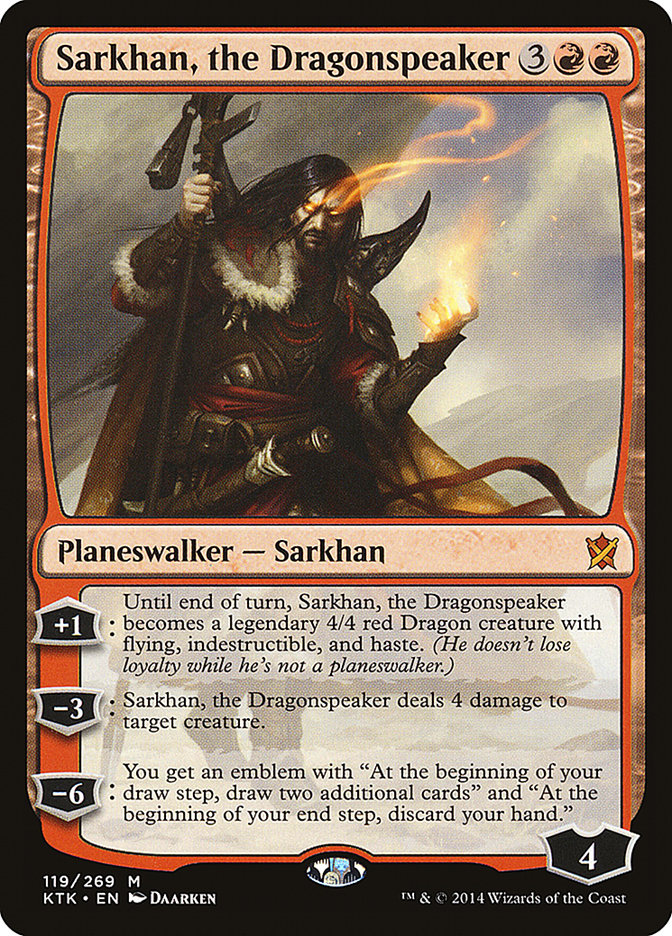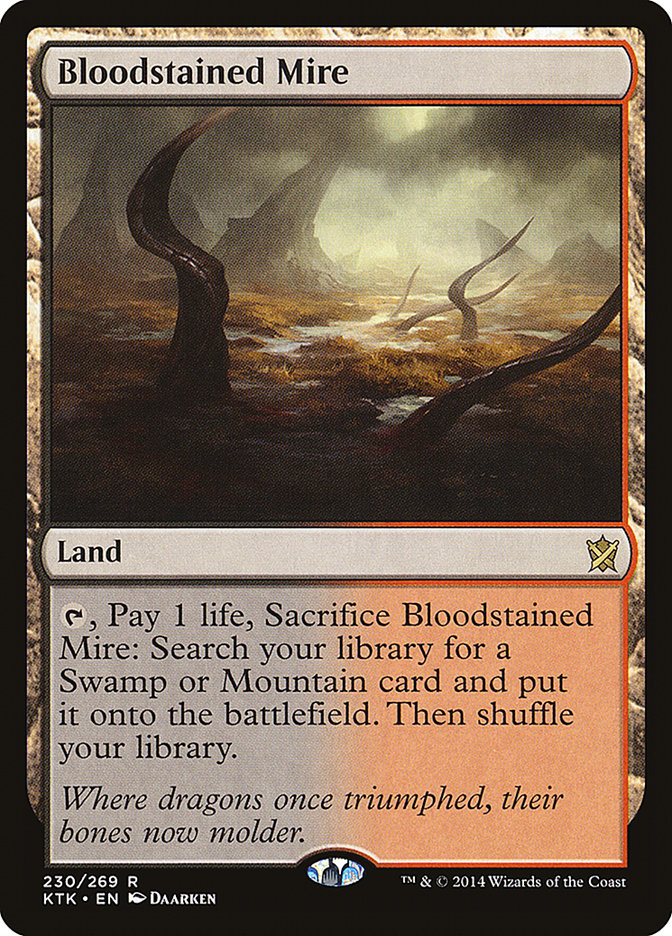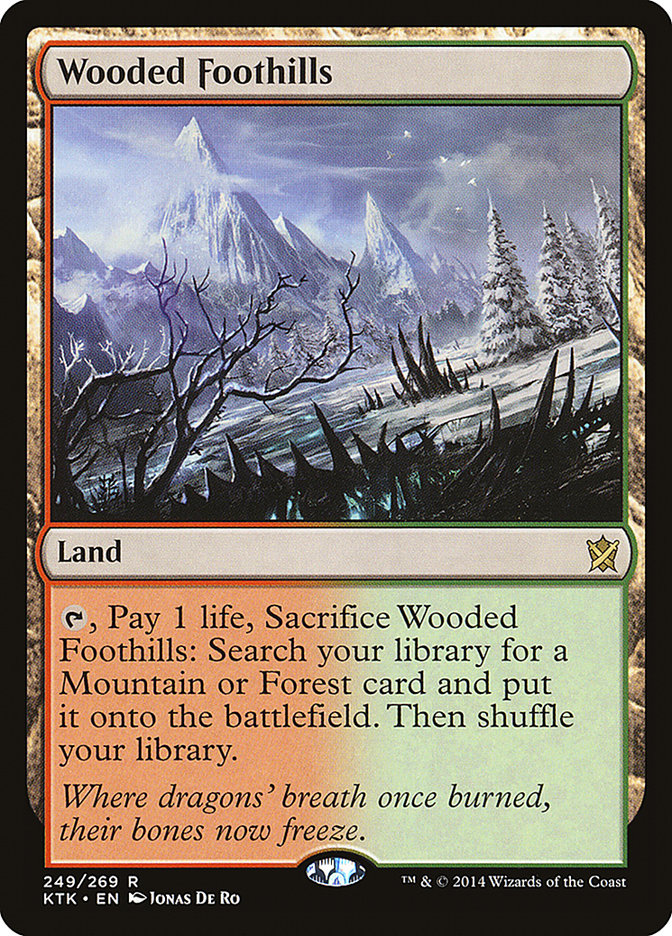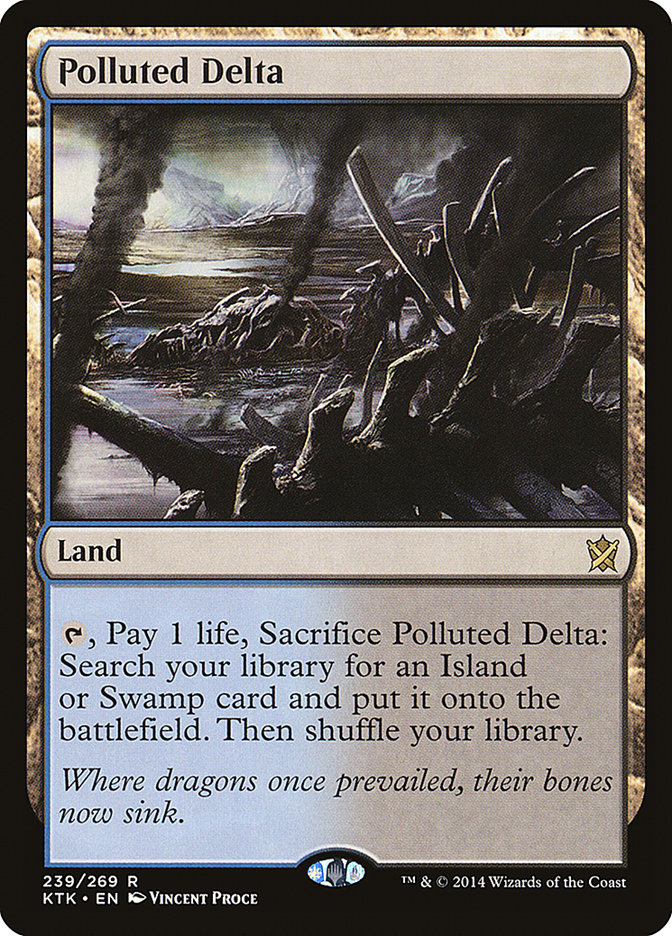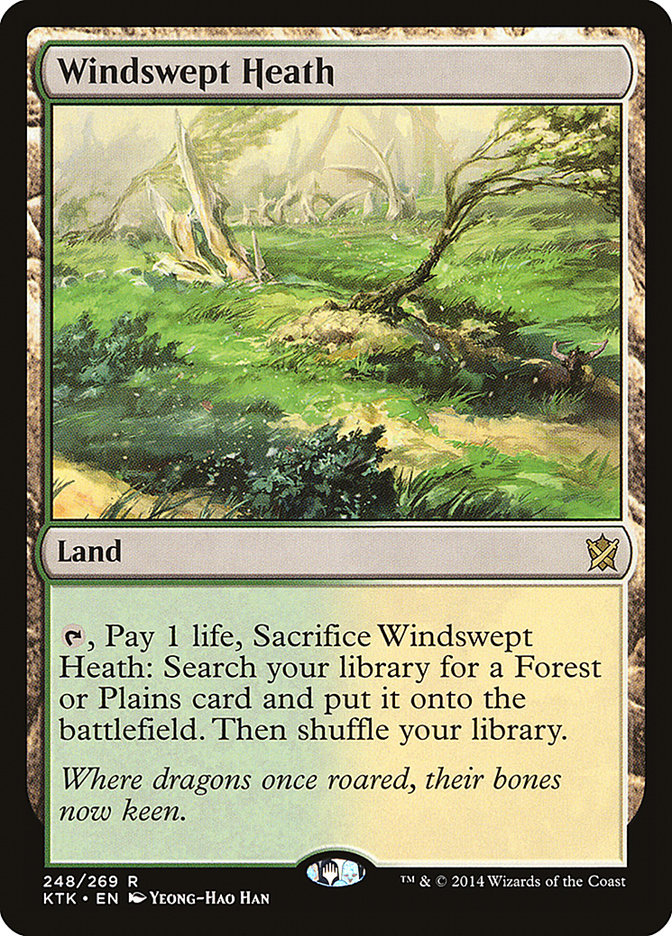The last time I reviewed a set, I set some guidelines for analyzing new
cards’ Legacy playability. I like all of them and think that they provide a good basis for spotting both the obviously powerful, playable-from-day-one hits
and the hidden gems of a set. The tropes, for those of you who hate clicking away from a page, are:
Step One: Look at the one-mana noncreatures, especially the blue ones. Do they do something interesting/powerful?
Step Two: Look at the two-mana blue cards.
Step Three: Look for cards whose power is conditioned on Legacy-specific things.
Step Four: Look for mostly-better versions of existing playables.
Step Five: Look for broken combo cards. This is kind of a “know it when you see it” thing.
Step Six: Look for some crazy, weird s***.
One of the things that I didn’t touch on in my M15 set review that I need to touch on here is how to spot a trap. Khans of Tarkir is full of
traps. Want to know what a trap is? This is a trap:
You might look at this card and think “wow, Temur Delver can make red, blue, and green mana, and this thing is enormous and plays well with a plan of
holding up mana!” Sorry, but I don’t see Savage Knuckleblade doing a whole lot of anything in Legacy. Here’s why:
The reason why three-color three-drops aren’t played in Legacy (sorry, Rhox War Monk, you barely saw play) is because they clash so obviously with the best
creature-accompanying land in the format: Wasteland. If you’re casting three-drops for the purpose of attacking with them, you’re probably also interested
in Stone Raining your opponent for free. When your three-drop asks you to stop playing your free Stone Rain and vice versa, your high-maintenance
three-drop isn’t getting a call back. Sorry, Wasteland is just that good. If you take only one thing away from this set review, let it be that three-color
cards are so incredibly rarely played in Legacy that I can only think of a few off the top of my head – Rhox War Monk, Rafiq of the Many, Progenitus,
Empyrial Archangel – and none of them were irreplaceable or particularly dominant.
With that said, let’s get down to the first item on our checklist: looking at cheap blue spells. As it turns out, we have some contenders!
All three of these can cost a single blue mana, which is a big deal in Legacy. The best mana cost in the format — by far — is a single blue mana. So
where can these cards fit in?
I’ll start with the card I’m the coolest on, which is Set Adrift. It reminds me of Unexpectedly Absent and Banishing Knack, two cards that looked exciting
and didn’t really go anywhere. Given how many cards are competing for graveyard-eating privileges, we can do better than a card that Submerges a
non-Emrakul permanent. Once you reread the card and notice that it’s a Sorcery, you won’t even miss it.
The other two cards are much more appealing. Stubborn Denial is a swingier Disrupt, while Treasure Cruise is a legitimate contender for various
attrition-oriented U/B strategies.
Right off the bat, Stubborn Denial is half a Spell Pierce. Nothing to write home about, but you can Force Spike a planeswalker or Sneak Attack, which ain’t
nothing.
The real fun begins when you have a Batterskull plus Germ token or a Tarmogoyf in play. Once you’re ferocious, you get a hard counter for a single mana
without leaving a Swan token behind or randomly getting punked by Jace, the Mind Sculptor. There is a real risk to relying on a single ferocious creature
to turn on the hard counter element of Stubborn Denial against removal-heavy decks though, since it’s trivial to set someone up for a two-for-one when you
have Swords to Plowshares plus noncreature and they have Tarmogoyf plus Stubborn Denial. Still, I would expect to see a real amount of Denials in slots
where you usually see Flusterstorm or Spell Pierce or Swan Song. Having more options there is great. Stubborn Denial will see some – but not a ton – of
play.
I think Treasure Cruise is getting too little press for what it does. To understand Treasure Cruise, you kind of have to understand what’s going on with
delve. You actually want very few cards with delve in your deck, as they’re parasitic – there’s little worse than having two Tombstalkers in your hand,
after all. Furthermore, you don’t want to have a ton of need for your graveyard. Deathrite Shaman and Tarmogoyf conflict with delve in pretty basic but
manageable ways, while you absolutely cannot play Treasure Cruise alongside Nimble Mongoose.
I envision Treasure Cruise as a one-to-two-of in decks with a ton of cantrips, cheap spells, and a desire to have the game go long. If you’re interested in
closing games out on low-resource situations, just play Sinkhole or Stifle. If you’re interested in trading off and refilling, Treasure Cruise may just be
the endgame that you’ve been looking for. To wit:
Creatures (14)
Planeswalkers (3)
Lands (20)
Spells (23)

This sort of deck has all sorts of ways to trade cards. In a world where people play a ton of removal though, you may not want Dark Confidant. Don’t get me
wrong – in the right tournament, Dark Confidant is the nut unbeatables. In the wrong tournament, it eats Lightning Bolt after Lightning Bolt as you wonder
why you keep losing tempo to literally every deck. In creature-antagonistic metagames, you can do a lot worse than paying one blue mana to draw three
cards. You can’t do it all the time, but you shouldn’t need to do it a ton. Liliana of the Veil is great with Treasure Cruise, grinding both players down
to nothing and protecting your neck while you wait for your golden boat to show up and take you to the promised land.
Is Treasure Cruise going to break Legacy open? I don’t know. I think two is a good starting point for the card, but I’m open to a dedicated
Turbo-Xerox-style strategy that tries to draw cards, counter spells, and delve for more cards. What would that look like?
Creatures (5)
Planeswalkers (4)
Lands (19)
Spells (32)

As you can see, this is a deck that is all about trading off and getting ahead with raw card advantage. It’s likely light by two removal spells, but I
wanted to see how far we could push the Thought Scour theme before reining it in. While this has its obvious flaws, it’s a fine blueprint for the sort of
deck that I think Treasure Cruise would fit into with the most success.
In a similar vein to Treasure Cruise (but at twice the price), I think that Dig Through Time has some legs.
Obviously it would be way too good to dump five cards in the graveyard and draw two, given the nature of a deck playing Dig Through Time, but at maximum
power this is basically two Brainstorm-plus-shuffles stapled together. Is that good? Sure. Is it what you want? Probably in a combo deck, right? Whereas
Treasure Cruise is paying you off for grabbing as many cards as possible, Dig Through Time cares more about the right cards. The possibility of
drawing the right two cards for two mana is a huge draw – just think about how good Reanimator or Sneak and Show decks are at Thoughtseizing and Dazing and
Lotus Petaling around, then envision a midgame sequence that shoves all the fetchlands and setup chaff aside, finds Entomb + Reanimate or Show and Tell +
Griselbrand, and casts them in the same turn.
Bang
.
Just out of nowhere, Dig plus the one-two punch. It’s not like those decks were in love with Preordain or whatever other cantrips, either. Dig Through
Time’s ability to find both halves of a two-card combo in a deck with any amount of redundancy is huge. Looking at seven cards all at once is a much bigger
deal than you realize until you’ve done it. Lim-Dul’s Vault is almost good enough at two mana, and it’s card-negative. Dig Through Time is like Lim-Dul’s
Vault on steroids after shoplifting a Divination.
I wouldn’t sleep on either of the eight-mana blue draw spells if I were you.
Of course, neither of those gets to take home the title of “best card in the set with eelve”, because the best card in the set has delve and it isn’t blue:
Every time you see a one-mana removal spell in Legacy, look at it for a while. Think about it. Consider its limitations. Consider its upsides. Consider the
decks that want something like this. Consider whether this solves any of their problems.
I think Murderous Cut is a big, big deal for basically any black deck in Legacy. Dismember was flashy but didn’t last, which makes sense because it didn’t
reliably kill Tarmogoyf and often didn’t kill the Big Fat Creature of the time, Knight of the Reliquary. Murderous Cut kills both of them. It kills
Griselbrand. It’s an instant, which some of black’s best removal spells aren’t. It doesn’t ask a lot, and it gives a ton back. Consider the fact that you
can delve through Thalia, Guardian of Thraben’s additional cost. Consider the fact that you won’t ever cascade into it.
I would play it in Shardless Sultai. I would play it in Sultai Delver. I would consider playing it in Storm. I would play it in various black midrange
decks. It is just outrageously good for its cost. I don’t think you’ll realize how small Delve 4 is until you start paying attention to your graveyard as a
resource.
As an added bonus, Murderous Cut pushes you toward playing more Ponders in your U/B/x midrange decks, which I’ve been advocating for months. As an added
frustration, Deathrite Shaman just got even better. Like that was possible, but still.
If you’re not in the market for fidgety blue midrange decks that want to fill up their graveyards, fear not! There’s actually a couple of really sweet
cards in here for you, too. If you’re in the business of casting Seething Song, you may want to consider Sarkhan, the Dragonspeaker:
I played Dragon Stompy back when the best thing you could do with five red mana was cast Arc Slogger. I’m not kidding – you just put a 4/5 in play and said
go. And it was mostly good enough.
Nowadays, there are lots of options. You can play Koth of the Hammer, for instance. If you have Emrakuls in your deck, you can play Pyromancy. If you’re
worried about Swords to Plowshares, you can even get in with Stormbreath Dragon. Now, it’s time to add another planeswalker to the list.
The sort of deck where Sarkhan excels is one where he’s accompanied by six to eight Blood Moons. Once you have someone in the soft lock, Sarkhan can come
down and pick off their preexisting threat, locking the game up entirely. If the board is at parity, Sarkhan can close the game out in five turns. If you
have Ensnaring Bridge, you can go ultimate and make sure that your opponent never attacks again. It is a nearly perfect planeswalker for the sort of
Mono-Red Chalice of the Void strategy that wants Chrome Mox and Seething Song. I heartily endorse. A sample list for your perusal:
Creatures (12)
Planeswalkers (8)
Lands (18)
Spells (22)

It’s possible that this is just a worse Imperial Painter, but Rakdos Pit Dragon has a place in my heart that will never go away. It may eat Lightning Bolts
for breakfast, lunch, dinner, and dessert, but sometimes you get to Seething Song, go hellbent, and pump up your Dragon. Those are the days you live for.
Oftentimes, that’s enough.
Last but certainly not least, there is a pretty sweet cycle of cards that might be Legacy-playable:
So hear me out on this. I know you have to pay a life and they don’t make any mana, but you get to find the original dual lands with them, so they’re
really good at manafixing. Plus, you can shuffle away the cards you don’t want from Ponder and Brainstorm. It’s going to break the format wide open, you
guys.
In all seriousness, the reprinting of the Onslaught fetchlands will help out the format a ton. It’s not going to solve the dual land issue, but it will
solve the “$90 Polluted Delta” issue. Given the extreme popularity of Underground Sea-colored strategies, Polluted Delta and Flooded Strand needed to come
back. They are very welcome, and I look forward to seeing lots of fetchlands with Khans of Tarkir expansion symbols on SCGLive every Sunday.
It’s easy to focus solely on the deckbuilding metagame implications of a set’s printing, but Khans of Tarkir’s biggest impact will be on Legacy’s
marketplace metagame. More people being able to afford more cards that they want to play is one of the best possible outcomes for any set. I’m thrilled
that many more fetchlands are going to make their way into the hands of players who want to play with them.
On a more personal note, this will be my last article for StarCityGames.com until November 2014. It’s a short time frame – just under two months – but I
would rather take a break than turn over content that I’m less than proud of. This is entirely my decision and it is entirely related to the industry in
which I work. I look forward to returning to the Premium lineup in a weekly or semi-weekly capacity after November 4th, and I’ve already booked a room for
Grand Prix New Jersey. If you have any questions about what to play in a tournament or you’re interested in my opinion on various and sundry topics, I’m
easily found on Twitter.
I’ll see you in a few months.
I was never very good at goodbyes. As an audience, you all are a delight to write for. I can’t wait to get back to it.
See ya.

